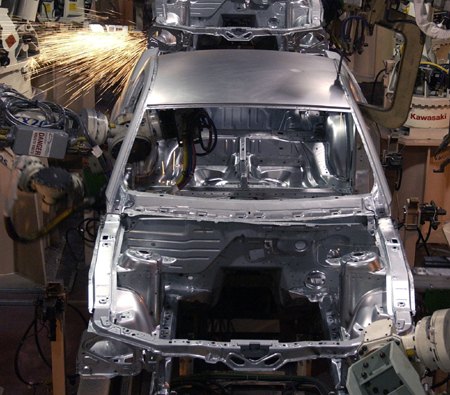Ford Death Watch 23: There Are 12k Parts in an Average Ford. This is a Story About Four of Them.
Enthusiasts don’t tend to wax eloquent about seat tracks. They’re the automotive equivalent of the sliding rails that support file cabinet drawers when you pull them all the way out. A vehicle’s front (and occasionally rear) seats slide forward on them, they slide backwards. Done. No surprise then that seat tracks aren’t mentioned in commercials. They’re never part of a car salesman’s spiel. And there’s no seat track website or blog. Yet seat tracks are a key part of any car, pickup, minivan, SUV or CUV.
In the early twenties, The Hudson Motor Car Company was the first automaker to implement sliding seat technology, making their products safer and more comfortable for a wide range of drivers. Not to belabor the obvious, Hudson’s adjustable seats helped height-challenged drivers reach the pedals and hold the steering wheel. They also allowed tall people to slide the seat backwards, to get enough room to operate the foot pedals effectively. They were an instant hit from the start; virtually every modern vehicle made uses seat tracks.
From a safety point-of-view, seat tracks hold the driver in place during a crash. Some cars (e.g. Mercedes SL) now have the entire seat belt and shoulder harness connected directly to the seat, adding additional weight to the mass the seat track must arrest. And, lest we forget, seat tracks must also be user-friendly, cheap, quiet, smooth, durable and reliable.
The Ford Motor Company hasn’t made a seat track in decades. Like roughly two thirds of the parts in an average Ford, seat tracks are provided by the automaker’s suppliers. For decades, Ford engineers designed the tracks, made blueprints, and then sent the drawings to likely suppliers for a price quote. The lowest price got the job.
In the late ‘80’s into the early ‘90’s, this subcontracting process changed. Ford cut back on its body engineering staff. They asked their suppliers to step up and do more of the design and engineering work. Many of their suppliers agreed. After all, the design process offered more work and increased control over product quality and price. The fact that the supplier base simply didn’t have all the engineering resources required to effectively realize this commitment didn’t seem to bother Ford, and it certainly didn’t bother the suppliers.
Not surprisingly, there were problems. Ford’s customers complained, warranty rates soared and some embarrassing failures ensued. Ford also discovered that they paid more for their seat tracks than most of their competitors.
Ford re-built their seat engineering department. A budget was appropriated. A dozen new engineers and managers were hired. Unfortunately, most of the new hires had worked at Ford’s seat track suppliers. They were, in fact, responsible for the original seat track quality “issues.” The problems persisted.
So Ford fired all their existing domestic suppliers and brought in a new one from abroad. This supplier had been supplying seat tracks to some of the world’s finest cars. They’d never triggered a single recall. Their engineering staff was well respected, their manufacturing facilities top-flight. And, perhaps best of all, they promised to find ways to save Ford money.
It didn’t take them long to solve the problem. All seat tracks do the same job, yet the new supplier soon discovered that Ford had well over a dozen seat tracks in different cars and trucks. Using the same tracks would save big money in manufacturing and inventory. More importantly, it would allow the engineers to spend their time developing the world’s best seat tracks– instead of spending time, energy and money on a dozen second-rate tracks.
The outside supplier also learned that every Ford car and truck had different mounting brackets or “feet.” Sometimes the differences in mounting points were as little as a quarter inch. Sometimes different sized bolts were used. Other feet were excessively heavy, far stronger than either the tracks or the floor to which they were attached. Occasionally the feet were too weak. The supplier calculated savings in the many millions by recommending parts commonality to many, if not all, of Ford’s products.
Common feet would mean that the engineers could apply all of their efforts to optimizing the design of one set of feet. Dollars and pounds would be saved. Naturally, the supplier expected Ford to be pleased when they presented their findings and recommendations. Who could argue with changes that saved money and improved quality?
It didn’t take long for Ford to respond. In no uncertain terms, the supplier was told never again to interfere with Ford’s engineering process. “Make the parts that we specify. Nothing more, nothing less.”
Although Ford CEO Alan Mulally hasn't turned his attention to seat rails, news reports reveal that he's taken-up the parts commonality crusade. It remains to be seen if Ford's $35m man can get there before the financial well runs dry, and if the vehicles made from these parts will capture the public imagination. One thing is for sure: the "bad old days" aren't over yet, and they can't end soon enough.
More by Bob Elton
Latest Car Reviews
Read moreLatest Product Reviews
Read moreRecent Comments
- Lou_BC Well, I'd be impressed if this was in a ZR2. LOL
- Lou_BC This is my shocked face 😲 Hope formatting doesn't fook this up LOL
- Lou_BC Junior? Would that be a Beta Romeo?
- Lou_BC Gotta fix that formatting problem. What a pile of bullsh!t. Are longer posts costing TTAC money? FOOK
- Lou_BC 1.Honda: 6,334,825 vehicles potentially affected2.Ford: 6,152,6143.Kia America: 3,110,4474.Chrysler: 2,732,3985.General Motors: 2,021,0336.Nissan North America: 1,804,4437.Mercedes-Benz USA: 478,1738.Volkswagen Group of America: 453,7639.BMW of North America: 340,24910.Daimler Trucks North America: 261,959


































Comments
Join the conversation
Well, eslai can believe the story or not. The reason there aren't names in the story (except for Ford) is because I'm an engineer in this business first, and a writer second. I do have some credentials in seats that are public record. My 2 papers delivered at SAE for starters. And about half of my 2 dozen patents are seat-related. And, of course, eslai can sit in an older Lincoln Town Car and run the seat back and forth, feeling the vibrations through his butt, as did thousand of unhappy oln owners. Or he can drive alone ina Ranger truck, and listen to the empty passenger's seat rattle in its tracks. He could lay on the floor of the current F150 and look at the feet on the seat track. I could go on. Bob
Can't say much about Japanese cars (never owned one), but in my family over the last 10 years we've had quite a few Fords. Let's compare. 1. 1985 Ford Tempo, bought used - no major problems, after 5 years of ownership got dented in a parking lot and insurance wrote it off as total loss. 2. 1995 Ford Explorer - still running. Did have to replace the engine this year, but that was my own fault (when you see an oil leak, do not try to drive to the nearest dealership because it is only 2 miles away :) 3. 2000 Ford Focus - still running, no major issues. 4. 1999 Mercury Cougar - sold that one after 2 years, no problems. 5. 2001 Volvo S60 - 92K, no major problems 5. 2001 Mercedes C-class. Cracked engine block at 35K. Multiple electrical problems. Has been in the shop more often than all Fords combined. 6. 2003 Audi A6. Just did 60K service and had to replace cam seals, secondary air pump and swaybar mountings - $3300 total. Make your own conclusions.